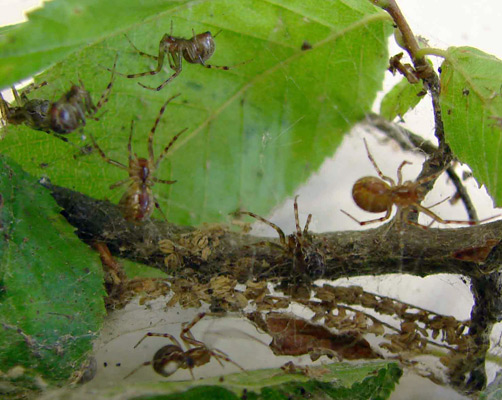This is Scientific American — 60-Second Science. I'm Jason G. Goldman.
What has eight legs, eight eyes, and lives together with thousands of others like it? Arachnophobia sufferers do not want to hear the answer—which is, spiders that live in large social groups.
It's pretty rare to find such group-living spiders. Of the 45,000 spider species we know about, only about 25 are social. These species weave massive webs and dwell in colonies of dozens, hundreds or even thousands of individual spiders.
"When we want to count the spiders inside the colony, what we do is, somebody rips apart the colony, basically, with their hands. And then, we call it 'making it rain,' and then dozens or hundreds of spiders basically shower down on little silken lines like little parachuters." University of California Santa Barbara arachnologist Jonathan Pruitt.
He and his students study social spiders in South Africa's Kalahari Desert. After counting and weighing hundreds of African social spiders, Pruitt and his team gave each spider a personality assessment—some are bold, others shy. They wanted to understand how the personality composition of a colony influences its interactions with predators, and how the colony behaved over time.

So the researchers combined their spiders into artificial groupings. Some of the experimental colonies were composed only of bold spiders, others of shy ones, and some had the two personality types in equal proportion. Then the researchers introduced predators to the party.
"The most voracious predator that they deal with is this pugnacious ant, Anoplolepis steingroveri, which is this horrible ant. If you dropped one of these social spiders onto the ground, it's identified in seconds. And so these ants rip it apart and then drag it over to their colony."
Turned out that the mixed-personality colonies were best able to learn from the repeated threat of ant raids, and build defensive nests to ward off attackers. Both the all-bold and all-shy colonies were less able to get it together enough to create their defensive structures, presumably because of too many—or not enough—leaders. The results are in the journal Animal Behaviour.
"The cool thing about social spiders is we know that they have these personality differences, and we know that societies are organized along these individual differences in behavior—actually very similar to the way that human societies are organized in a lot of ways."
Thanks for listening Scientific American — 60-Second Science Science. I'm Jason G. Goldman.












